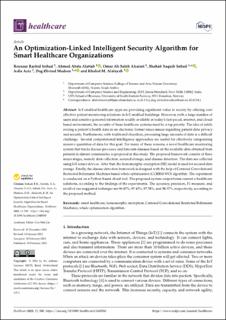| dc.contributor.author | Irshad, Reyazur Rashid | |
| dc.contributor.author | Alattab, Ahmed Abdu | |
| dc.contributor.author | Alsaiari, Omar Ali Saleh | |
| dc.contributor.author | Sohail, Shahab Saquib | |
| dc.contributor.author | Aziz, Asfia | |
| dc.contributor.author | Madsen, Dag Øivind | |
| dc.contributor.author | Alalayah, Khaled M. | |
| dc.date.accessioned | 2023-06-05T11:45:45Z | |
| dc.date.available | 2023-06-05T11:45:45Z | |
| dc.date.created | 2023-03-21T09:53:10Z | |
| dc.date.issued | 2023 | |
| dc.identifier.citation | Irshad, R. R., Alattab, A. A., Alsaiari, O. A. S., Sohail, S. S., Aziz, A., Madsen, D. Ø. & Alalayah, K. M. (2023). An Optimization-Linked Intelligent Security Algorithm for Smart Healthcare Organizations. Healthcare, 11(4), Artikkel 580. | en_US |
| dc.identifier.issn | 2227-9032 | |
| dc.identifier.uri | https://hdl.handle.net/11250/3069932 | |
| dc.description.abstract | IoT-enabled healthcare apps are providing significant value to society by offering cost-effective patient monitoring solutions in IoT-enabled buildings. However, with a large number of users and sensitive personal information readily available in today’s fast-paced, internet, and cloud-based environment, the security of these healthcare systems must be a top priority. The idea of safely storing a patient’s health data in an electronic format raises issues regarding patient data privacy and security. Furthermore, with traditional classifiers, processing large amounts of data is a difficult challenge. Several computational intelligence approaches are useful for effectively categorizing massive quantities of data for this goal. For many of these reasons, a novel healthcare monitoring system that tracks disease processes and forecasts diseases based on the available data obtained from patients in distant communities is proposed in this study. The proposed framework consists of three major stages, namely data collection, secured storage, and disease detection. The data are collected using IoT sensor devices. After that, the homomorphic encryption (HE) model is used for secured data storage. Finally, the disease detection framework is designed with the help of Centered Convolutional Restricted Boltzmann Machines-based whale optimization (CCRBM-WO) algorithm. The experiment is conducted on a Python-based cloud tool. The proposed system outperforms current e-healthcare solutions, according to the findings of the experiments. The accuracy, precision, F1-measure, and recall of our suggested technique are 96.87%, 97.45%, 97.78%, and 98.57%, respectively, according to the proposed method. | en_US |
| dc.language.iso | eng | en_US |
| dc.rights | Navngivelse 4.0 Internasjonal | * |
| dc.rights.uri | http://creativecommons.org/licenses/by/4.0/deed.no | * |
| dc.title | An Optimization-Linked Intelligent Security Algorithm for Smart Healthcare Organizations | en_US |
| dc.type | Peer reviewed | en_US |
| dc.type | Journal article | en_US |
| dc.description.version | publishedVersion | en_US |
| dc.rights.holder | © 2023 by the authors. | en_US |
| dc.source.volume | 11 | en_US |
| dc.source.journal | Healthcare | en_US |
| dc.source.issue | 4 | en_US |
| dc.identifier.doi | https://doi.org/10.3390/healthcare11040580 | |
| dc.identifier.cristin | 2135602 | |
| dc.source.articlenumber | 580 | en_US |
| cristin.ispublished | true | |
| cristin.fulltext | original | |
| cristin.fulltext | original | |
| cristin.qualitycode | 1 | |

